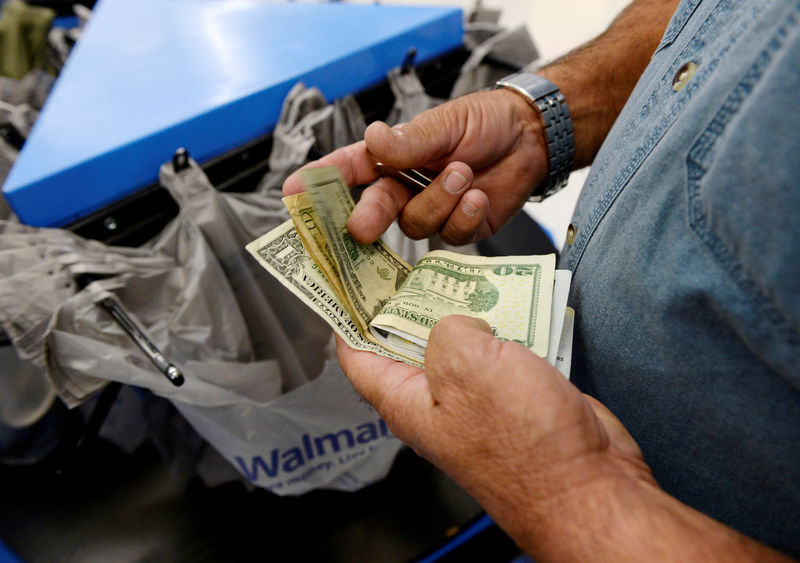By Ann Saphir
SAN FRANCISCO (Reuters) - In late 1969, with U.S. unemployment at 3.5%, consumer prices were rising at around 6%, and inflation on some items like clothing and housing were running even hotter.
The jobless rate today, at 3.6%, is just about where it was nearly half a century ago, but prices are going nowhere fast.
Housing costs, rising about 9% a year back then, are now up 3.4% over the last year. Apparel prices, which rose more than 6% in late 1969, fell nearly 3% in April from a year earlier for their biggest annual decline in around 16 years.
And overall, U.S. prices as measured by the consumer price index are rising at a staid annual pace of 2%. By the Federal Reserve's preferred measure, inflation is a meager 1.6%.
And that's a big problem.
For now, the absence of price pressures lets Fed policymakers keep interest rates on hold to nurse economic growth without fear of unleashing runaway inflation.
But it is feeding deeper doubts about the Fed's ability to lever inflation up to its 2% goal, a level the central bank says is needed to cushion against growth-sapping deflation in a future economic downturn.
Repeated failure to deliver on its 2% goal is the main reason the Fed is now undertaking a yearlong review of how best to engineer stable prices and full employment.
Bottom line, inflation's muted response to a hot labor market upends conventional economic thinking that a super-low unemployment rate will force companies starved for workers to raise wages, giving households more money to spend. That then pushes up the prices of what they want to buy.
"We wonder why, with unemployment so low, the inflation hasn’t come up to our target in a sustainable way," San Francisco Federal Reserve Bank President Mary Daly said in Dallas last month. "You are not going to be an effective policymaker in my judgment unless you figure out what’s getting in between those models."
LOOKING BEYOND UNEMPLOYMENT
Explanations, from Daly and other policymakers, have run the gamut.
They include sharp but onetime price drops for cell phone plans and clothing; an aging U.S. population that is a long-term drag on growth; and the decline of unions and their power to win bigger wage gains for members.
Policymakers also point to the Fed's own success in reining in past high inflation, which makes people and businesses worry less about future inflation even when labor markets are strong. Such muted inflation expectations mean consumers don't feel much urgency to buy items now lest they become more expensive later, which in turn keeps a lid on prices.
And increasingly they note changes from globalization and technology. Amazon (NASDAQ:AMZN) Inc and Alphabet (NASDAQ:GOOGL) Inc's Google give people an easy way to shop online for the best price, robbing companies of historical pricing power. Artificial intelligence may boost productivity but also eliminate some jobs, clipping wage inflation.
All have a common theme: Whatever is driving inflation, it is way more complicated than simply the level of unemployment.
"One of the things that I think about a lot is, to what extent are these structural changes happening in such a way that the old historic relationships and the old historical models are not telling us enough? They don’t map onto how the economy and the world is actually working," Atlanta Fed President Raphael Bostic said last month.
To see how technology is impacting inflation, for instance, policymakers need more than a model, he said. "We actually have to be more aggressive and more engaged about calling people ... (to ask), is it the same way that it was six months ago, 12 months ago, 24 months ago - has your cost structure changed because of changes in technology?"
Any new approach to Fed policy may need to recognize the drivers of low inflation are outside of Fed control.
Fed Governor Lael Brainard recently floated the idea of encouraging above-target inflation opportunistically, by making it clear that the Fed would not raise rates in the face of widespread price increases from, say, higher tariffs.
YARDSTICKS
Complicating the inflation debate is not everyone agrees how best even to measure it.
The Consumer Price Index, the best known of U.S. inflation measures, is rising at about a 2% annual pace.
The Fed's 2% target, however, is tied to the Personal Consumption Expenditures Price Index, a somewhat different basket of goods and services that typically tracks a half percentage point lower than CPI.
But because big swings in food and energy prices can mask underlying trends, the Fed relies on a measure called core PCE that strips those out. It came in at 1.6% in April.
And recently Dallas Fed economists have won the ear of Fed Chair Jerome Powell and other influential Fed policymakers, arguing their gauge best reflects inflation's trajectory by each month lopping off items with outsized price gains or losses. In recent months the Dallas Fed trimmed mean has held steady at about 2%.
Still, no matter the specific gauge, inflation is much lower than it used to be, despite low unemployment, and that has Fed policymakers worried.
"People are starting to say, 'my lord, if you can't generate even 2% inflation in a good economy, maybe in a downturn we are going to have some deflationary challenges,'" Dallas Fed President Robert Kaplan said last month in Brownsville, Texas. "We want to get to 2%."

(Graphic: Inflation puzzle link: https://tmsnrt.rs/2HHit1w).